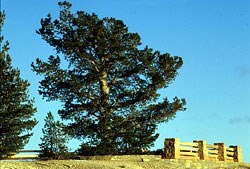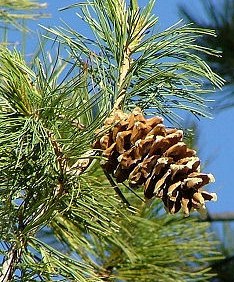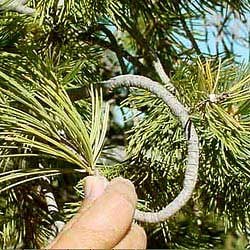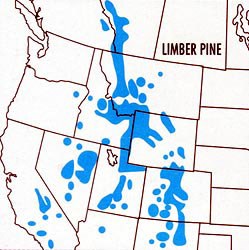|
Common Name: Limber Pine Scientific Name: Pinus flexilis Size (height & diameter) English & Metric: 40-50 ft. (12-15 m) tall, trunk 24-36" (.6-.9 m) in diameter Habitat: Dry rocky slopes, ridges, cliff-tops and high mountains-where most other trees cannot grow. Flowering Season: N/A not a flowering plant Range: Central and Northern Rocky Mountains and the Great Basin. 
nps photo The Limber Pine, a very durable tree, grows near timberline, from 5,000 to 12,000 feet. Because it is an exceptionally slow growing species, it does not compete well with the other conifers in its habitat. So you will only find it growing in places where White Fir, Western Hemlock, Lodgepole Pine, Douglas-fir and Engelmann Spruce can't survive. This often means southwestern slopes, on the very edge of cliffs or in pockets on talus slopes. Ironically, it's the Limber Pines that will eventually stabilize enough soil to make it possible for the other trees to grow on the same location. This pine has a short, thick trunk with an irregular crown and can develop a stunted, twisted form, very low to the ground. Compared to many of the other conifers, this is a relatively small tree, usually 25 to 30 feet tall and about 12 to 30 inches in diameter. The cones are light brown, 3-10 inches long without prickles, but with very thick scales. They tend to hang down from the branches. The needles are found in bundles of five, in tufts, at the ends of the branches. The tree sheds its needles about every five years. 
lee dittmann The Limber Pine's branches are so limber that they can be bent double without breaking, a distinct advantage in withstanding severe winds and snow loads. The heartwood of the Limber Pine is dense, seasons well, and works easily, but does not last well so it is of little commercial significance. Limber Pine nuts are also edible although not quite as tasty or nutritious as the pinyon nuts. Like Colorado Pinyon, Pinus edulis, Limber Pines are dependent on Pinyon Jays and Clark's Nutcrackers for their survival. To learn more about this fascinating symbiotic relationship consult the Colorado Pinyon page of this website. 
NPS Photo A favorite trick for those who know the secret is that Limber Pine boughs can be tied in knots. While this can be quite amusing, unfortunately too many limbs are broken in the attempt. For a slow-growing species like Limber Pine that must live in terrible growing conditions, every limb is precious. Please be responsible with this knowledge and only carefully attempt overhand knots. Furthermore, one of the ethics of the National Park Service is to make every effort to leave no trace of your passing. So, if you must try tying a knot for yourself, please untie the knot when you are done. Limber Pines also suffer from those (usually photographers) who feel they have to leave the trail and walk right up to the brink of the cliff for the best view. Notice that many Limber Pines along the Rim Trail between Sunset and Sunrise Points are dying. Why? Because much of their root systems are completely exposed after human foot traffic has compacted and worn away the soil. These roots and the entire tree's health are in jeopardy, as little rain can infiltrate compacted soil. Furthermore, as people step on the exposed tree roots, their shoes wear away the protective covering of bark, which weakens and eventually kills the tree. Please (especially you photographers), be a responsible nature enthusiast and stay on the trails. 
NPS image Limber Pine can be consistently found at the edges of cliffs or sometimes even on the tops of hoodoo heads where a Clark's Nutcracker or Pinyon Jay has cached some pine nuts that it didn't return for. The most famous Limber Pine in the park is the one that stands near the corner of the Sunrise Point railing. It is a testament to the rate that Bryce Canyon is eroding to the west, approximately 2-4 feet every 100 years. Please stay behind the railing so as not to further erode or compact the soil near this little tree. Doing so would ruin future erosional data this tree could provide.
Further Reading: Buchanan, Hayle 1992. Wildflowers of Southwestern Utah. Bryce Canyon Natural History Association. Bryce Canyon, Utah Lanner, Ron. & Rasmuss, Christine. 1988. Trees of the Great Basin: a Natural History. University of Nevada Press. Little, Elbert L. 2001 National Audubon Society Field Guide to Trees - Western Region. Random House Inc. New York, NY Stuckey, Martha & Palmer, George. 1998. Western Trees: A Field Guide. Falcon Publishing, Inc. Helena, MT |
Last updated: March 3, 2025
